The Cotton Harvest Tour in Los Baños hosted by the Sustainable Cotton Project
Cotton is complex. It is a fiber we wear every day, but don’t spin as often as wool or silk. It is a significant state agricultural crop accused of requiring too much water and harmful chemicals. Cotton is a global commodity with major impact locally. Growing cotton requires cooperation of an extended community: growers, farm bureaus, university research, co-op processing, marketing and financing.
Each fall the Sustainable Cotton Project (SCP) hosts an educational tour during harvest. The tour visits local farms, gins, community and city officials to illustrate the complexity of cotton farming. Large tour buses barely fit one lane dirt roads between fields. This year’s tour was blessed with warm weather compared to 2009’s torrential rain. Farmers, however, work in any weather but pick specific tasks based on conditions of the moment.
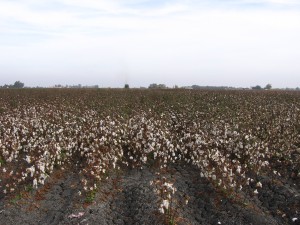
Cotton Field ready for harvest
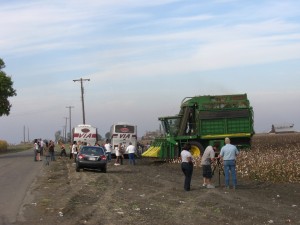
The first stop on the cotton harvesting tour
The first tour stop was at a field ready to harvest, but fibers were still too wet from dew at 9AM for the harvesters to work. They waited over an hour for the sun to dry fibers. Across the miles of flat land, we could watch harvesters crossing fields and trucks picking up for the gin.
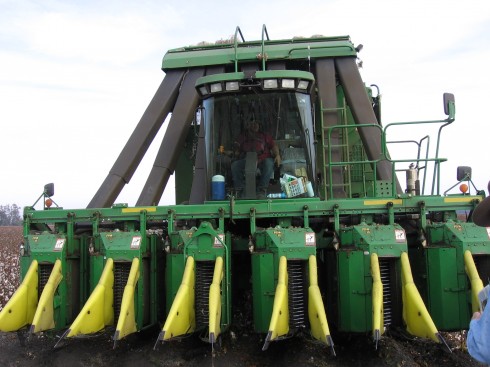
Front view of the cotton harvester
SCP’s original goal was to convert local farmers to organic methods from chemically intense methods. Their mission has changed since their founding in 1996 and they now work cooperatively with farmers on reducing agricultural chemical use, implementing integrated pest management and choosing non-genetically modified seed. They also have a consumer/industry education program to grow demand for their trademarked Cleaner Cotton. It’s not organic, but environmentally ‘cleaner’ than conventionally grown cotton.
The annual farm tour brings together the farm community with fiber consumers. We stepped off the tour bus into fields with the farmers and SCP field scouts. The first person we met was a third generation farmer, Chad Crivelli. He grows cotton in rotation with field corn, tomatoes, alfalfa and melons, and was already planning the next year’s plantings, balancing which fields needed to rotate crops against the futures prices for that crop. First, he needed to complete the cotton harvest before the December 15th deadline for plowing under his fields. SCP field scouts are experienced agricultural workers that walk local fields, checking crop conditions. They often are the first to spot pests, irrigation glitches or other problems that would reduce crop yield. Also in the field was Peter Goodell, a pest management expert from the University of California that has worked in cotton fields for decades. Pete explained the current practice of pest control as towards the biologic end of a range of options. By understanding how and where each pest thrives and who eats them, farmers discourage and limit pests rather than kill them with chemicals. Cotton fields are planted with attractive barriers of alfalfa or flowers. Lady bugs, lace wings and wasps are added to a field when required. Fields are plowed under and left ‘host free’ between December 15 and March 15.
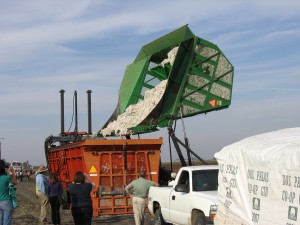
Loading cotton into a compressor before transport to the gin
The second tour stop was in a field next to an irrigation channel that had been harvested already and plowed under. A few stalks of cotton poked through the dirt near the road. This field had drip irrigation system installed recently, carefully engineered for even distribution of water across many acres that were not completely flat. Each row of drip line had its GPS location and depth recorded so that subsequent plowing would not damage the lines. Drip irrigation offers a major saving in labor over the sprinkler system of watering crops that requires heavy pipe to be moved regularly across fields. Drip systems use water very effectively as it flows from field to field until the water is completely absorbed by the soil. In spite of a demonstrated 30% increase in yield and subsidized cost of installation at $1,000 per acre local farmers took over 20 years to convert to drip irrigation.
Next tour stop was the The Dos Palos Co-op gin just east of Los Baños. This gin serves cotton farmers within 200 miles but only needs to operate three months of the year. Harvesters dump their load into a compressor that bails a block of fiber to exactly fit the back of a flat bed truck. In one field we passed, there were 16 blocks waiting to be picked up by the gin’s fleet of 21 trucks, 16 round trips from gin to field back to the gin.

Compressed cotton being unloaded at the gin
The truck backs up to a roller conveyor, lifts its bed and slides the block of fiber onto the conveyor and then takes off to pick up another block. The conveyor rolls the block into a machine that decompresses the raw cotton, fluffs it and blows it through a conduit to the top of the ginning machines.
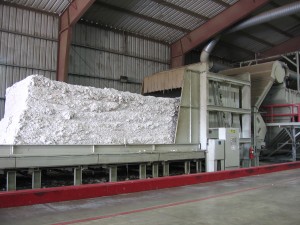
compressed bale starting through the gin
Seed falls to the bottom of the gin to be collected for animal feed. Regulations and strict criteria restrict which seed may be saved for planting next year. Husks and larger bits of hard plant material are separated out for composting. Lint is compressed into 500 pound bales covered with non woven, seamless bags. As the bales roll towards the fork lift pick up, people tag each bale with field location, grower and gin batch. They pull a fiber sample, and record everything in their laptops. Bale data are reported to the Department of Agriculture. After the gin sample is inspected, the government loan value is paid to the farmer. If the cotton marketer sells the bale for more than the loan value the difference is paid to the farmer upon completion of the sale.
On the tour day, bales of cotton were being trucked to Oakland for shipment to Taiwan and China spinning mills as fast as each truck could be loaded. The gin often processes fiber then warehouses the bales until sold by a cotton marketer. Market price on the day of the tour was $1.47 / pound. The Los Baños area and California is known for growing long staple high quality acala and pima cottons that command a premium over commodity market price. Spinning mills source cotton from many locations and blend it to meet the technical specification from their customer. A high quality thread may contain 10% or less of high value California grown cotton. What we saw harvested and ginned November 4th would become fashions for sale in 2012.
California does not have the infrastructure to process organic cotton and pay the costs for certification. To be certified organic, a field would take years of organic farming before testing, with no contamination from neighboring operations. Every step of the harvest, transport, ginning, spinning and weaving processes would require organic certification and separation from non-organic cotton. A warehouse could not store both organic and non-organic bales of cotton. State and federal regulations, cotton growing associations, local gins, transportation and warehousing, and even farm financing do not encourage organic farming. Farmers want to see results before committing their land and investing at least a year of their time and money. The Sustainable Cotton Project has proved that their suggestions reduce chemical use and increase quality and yield. Farmers are tempted to plant more cotton in 2011 as future prices are up but there’s more profit from planting pomegranates.
Can the spinner, weaver, fiber artist grow their own cotton and process it? The qualified answer is that you can, but.. cotton plants need more hot weather for more days than tomatoes, they need less nitrogen in the soil than other crops, consistent quantities of water and ways to manage some significant pests and diseases. Also, California has state laws and local regulations that restrict the growing of cotton. One regulation, the San Joaquin Valley One-Quality Law, restricts the variety grown in specific areas in order to protect the quality, consistency and health of this important crop. Local agricultural regulations are structured to protect commercial growers. One on-line source of non commercial quantities of seed specifically states that buyers are responsible for complying with all local cotton growing regulations. With that said, Acala, pima, and colored varietals of cotton seed are readily available. If you live in a warm area, consult your local Ag Department and consider growing your own.
Find out more:
Cleaner Cotton Campaign in California with the Sustainable Cotton Project, www.sustainablecotton.org
Marcia Gibbs: 530-756-8518 Ext. 34 or marcia@sustainablecotton.org
2010 Tour: http://www.sustainablecotton.org/html/events.html
Environmental Justice Foundation
https://www.ejfoundation.org.uk/shopforejf/index.php?route=information/information&information_id=7
and their reports on cotton world wide http://www.ejfoundation.org/page93.html
www.aboutorganiccotton.org
Suggested reading
• Big Cotton: How A Humble Fiber Created Fortunes, Wrecked Civilizations, and Put America on the Map and Cotton: The Biography of a Revolutionary Fiber. one book, two titles, by Stephen Yafa
• King of California J.G. Boswell and the Making of A Secret American Empire by Mark Arax and Rick Wartzman
• The Travels of a T-Shirt in the Global Economy: An Economist Examines the Markets, Power, and Politics of World Trade by Pietra Rivoli
Need some food for thought? Click here